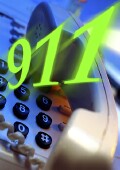
FRIDAY, March 16 (HealthDay News) — Slightly more than half of Americans with stroke symptoms call 911, a rate that hasn’t changed since the mid-1990s, a new study finds.
The study highlights the need for more public education about stroke symptoms and the importance of early treatment, said the researchers from New York-Presbyterian Hospital/Weill Cornell Medical Center.
“People do not always recognize the seriousness of stroke symptoms, or instead of calling 911 they may call their primary-care physician for an appointment and lose valuable time as the damage becomes irreversible,” study leader Dr. Hooman Kamel, a neurologist at New York-Presbyterian Hospital/Weill Cornell, said in a medical center news release.
The researchers examined data from more than 1,600 stroke cases collected by the National Hospital Ambulatory Medical Care Survey between 1997 and 2008.
The analysis revealed that just 51 percent of adults who were diagnosed with stroke at an emergency department arrived via ambulance, and that rate had not significantly changed during the 11-year study period.
The findings were published in a research letter in the March 14 issue of the Journal of the American Medical Association.
Recovery from stroke often is possible with early treatment, Kamel said.
“We have drugs and surgeries that can minimize brain damage from a stroke, but they can be used only within a few short hours,” Kamel said in the release. “When stroke victims or bystanders quickly recognize the symptoms of a stroke and call 911, patients are more likely to arrive in time to receive these treatments.”
Common warning signs of stroke include:
- Sudden numbness or weakness in the face, arms or legs, especially on one side of the body
- Sudden confusion
- Sudden trouble speaking or understanding
- Sudden trouble seeing in one or both eyes
- Sudden trouble walking, dizziness, or loss of balance or coordination
- Sudden, severe headache with no known cause
You should call 911 if you or someone else experiences any of these symptoms, according to the U.S. National Institute of Neurological Disorders and Stroke.
More information
The American Academy of Family Physicians has more about stroke.

